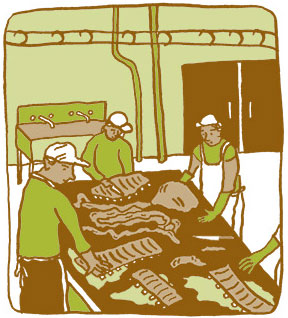Part of the Series
Ladydrawers
 In Ladydrawers’ latest strip in the “Growing Season” comics exploration of public health, race and food policy, Laura Ķeniņš and Anne Elizabeth Moore explore how the production of certain popular meat products is linked to corporate malfeasance, public health risks and profound, citywide racism – not to mention all the weird additives. For workers and eaters alike, the world of meat processing is packed with dangers.
In Ladydrawers’ latest strip in the “Growing Season” comics exploration of public health, race and food policy, Laura Ķeniņš and Anne Elizabeth Moore explore how the production of certain popular meat products is linked to corporate malfeasance, public health risks and profound, citywide racism – not to mention all the weird additives. For workers and eaters alike, the world of meat processing is packed with dangers.

Footnotes
1. “Baby Names,” Baby Center. https://www.babycenter.com/baby-names-bacon-579925.htm (accessed December 1, 2015)
2. “Media Advisory: GAP Whistleblowers Available to Speak on Food Safety Concerns at Largest Hormel Pork Plant,” Government Accountability Project press release, November 11, 2015.
3. Denise Grady, “A Medical Mystery Unfolds in Minnesota,” The New York Times (February 5, 2008). https://www.nytimes.com/2008/02/05/health/05pork.html?pagewanted=all (accessed December 1, 2015)
4. Ibid.
5. The US Census data for 2010 lists Austin, Minnesota, as 86.8 percent white and 15.4 percent Hispanic or Latino, with a population of 12,718. Compare this to the 4,869,291 hogs slaughtered at the facility per year: That’s about 383 swine per person. See https://quickfacts.census.gov/qfd/states/27/2702908.html and https://wtfhormel.com/#take_action for figures.
6. Tom Philpott, “Everything You Didn’t Want to Know About Hormel, Bacon, and Amputated Limbs,” Mother Jones (October 15, 2014). https://www.motherjones.com/tom-philpott/2014/10/chain-ted-genoways-spam-hormel (accessed December 2, 2015). See also: https://sundown.afro.illinois.edu/sundowntownsshow.php?id=67 for disturbing historical accounts of white supremacist violence in Austin.
7. “Hormel Foods,” OpenSecrets.org. https://www.opensecrets.org/lobby/clientsum.php?id=D000026518&year=2015 (accessed December 2, 2015).
8. Philpott (Ibid).
9. “Media Advisory” (Ibid).
Join us in defending the truth before it’s too late
The future of independent journalism is uncertain, and the consequences of losing it are too grave to ignore. To ensure Truthout remains safe, strong, and free, we need to raise $22,000 by the end of today. Every dollar raised goes directly toward the costs of producing news you can trust.
Please give what you can — because by supporting us with a tax-deductible donation, you’re not just preserving a source of news, you’re helping to safeguard what’s left of our democracy.